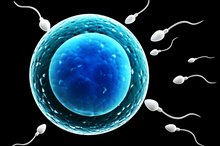What Causes Ejaculation?
Ejaculation is the emission of semen, a mixture of fluids and sperm, from the male reproductive tract. Generally the result of physical or mental sexual stimulation, ejaculation accompanies almost all orgasms, though some men achieve orgasm without ejaculation either through purposeful training or through physical abnormalities in the reproductive tract. While the prerequisite to ejaculation is sexual arousal and erection of the penis, these alone are not sufficient to produce an emission—instead, a sequence of events leads up to ejaculation.
If you are experiencing serious medical symptoms, seek emergency treatment immediately.
Pre-Ejaculatory Fluid
During the period of arousal that precedes ejaculation, glands of the male reproductive system produce pre-ejaculatory fluid that prepares the urethra for the movement of sperm. This fluid, largely secreted by an organ situated close to the base of the penis and called the bulbourethral gland, coats the urethra so that sperm are not damaged by their high-speed trajectory during ejaculation.
Seminal Emission
What Are the Causes of Painful Ejaculation?
Learn More
; March 2001'). During seminal emission, the bladder neck closes off, preventing retrograde seminal movement. Most men have some control over the process of seminal emission, and can delay it a bit as desired. Once it occurs, however, ejaculation is eminent.
- During seminal emission, the bladder neck closes off, preventing retrograde seminal movement.
- Most men have some control over the process of seminal emission, and can delay it a bit as desired.
Propulsatile Ejaculation
Once semen has been deposited in the urethra, the second phase of ejaculation involves its expulsion. This is accomplished through the rhythmic muscular contractions of the pelvic region that characterize orgasm, notes Dr. Elliot. Further, the seminal vesicles and prostate gland—also fluid-producing glands responsible for secreting components of the liquid portion of semen—contract, squeezing their seminal contributions into the urethra for ejaculation along with sperm. While contractions of the pelvic floor muscles are not directional and can’t force sperm toward the opening of the penis to the outside, prior closure of the bladder neck ensures that ejaculation occurs through the penile opening, called the urinary meatus.
- Once semen has been deposited in the urethra, the second phase of ejaculation involves its expulsion.
- While contractions of the pelvic floor muscles are not directional and can’t force sperm toward the opening of the penis to the outside, prior closure of the bladder neck ensures that ejaculation occurs through the penile opening, called the urinary meatus.
Related Articles
References
- “Human Physiology”; Lauralee Sherwood, Ph.D.; 2004
- “Medical Aspects of Human Sexuality"; Clinical physiology and pathophysiology of ejaculation and orgasm; Stacy Elliot, M.D.; March 2001
- Hu QB, Zhang D, Ma L, Ng DM, Haleem M, Ma Q. Progresses in pharmaceutical and surgical management of premature ejaculation. Chin Med J. 2019;132(19):2362-2372. doi:10.1097/CM9.0000000000000433
- Wylie K, Linton KD. Recent advances in the treatment of premature ejaculation. Drug Design, Development and Therapy. January 2010:1-6. doi:10.2147/dddt.s6077.
- Clement P, Giuliano F. Physiology and Pharmacology of Ejaculation. Basic Clin Pharmacol Toxicol. 2016;119 Suppl 3:18-25. doi:10.1111/bcpt.12546
- Alwaal A, Breyer BN, Lue TF. Normal male sexual function: emphasis on orgasm and ejaculation. Fertil Steril. 2015;104(5):1051-60. doi:10.1016/j.fertnstert.2015.08.033
- Safarinejad MR. Relationship between premature ejaculation and genetic polymorphisms of the dopamine transporter gene (SLC6A3). BJU Int. 2011;108(2):292-6. doi:10.1111/j.1464-410X.2010.09809.x
- American Cancer Society. Can Cancer Affect a Man's Ability to Ejaculate? Last revised February 24, 2017.
- Clement P, Giuliano F. Physiology and pharmacology of ejaculation. Basic Clin Pharmacol Toxicol. 2016;119 Suppl 3:18-25. doi:10.1111/bcpt.12546
- Courtois F, Carrier S, Charvier K, Guertin PA, Journel NM. The control of male sexual responses. Curr Pharm Des. 2013;19(24):4341-56.
- Giuliano F. Neurophysiology of erection and ejaculation. J Sex Med. 2011;8 Suppl 4:310-5. doi:10.1111/j.1743-6109.2011.02450.x
- Safarinejad MR. Relationship between premature ejaculation and genetic polymorphisms of the dopamine transporter gene (SLC6A3). BJU Int. 2011;108(2):292-6. doi:10.1111/j.1464-410X.2010.09809.x
Writer Bio
Kirstin Hendrickson is a writer, teacher, coach, athlete and author of the textbook "Chemistry In The World." She's been teaching and writing about health, wellness and nutrition for more than 10 years. She has a Bachelor of Science in zoology, a Bachelor of Science in psychology, a Master of Science in chemistry and a doctoral degree in bioorganic chemistry.








